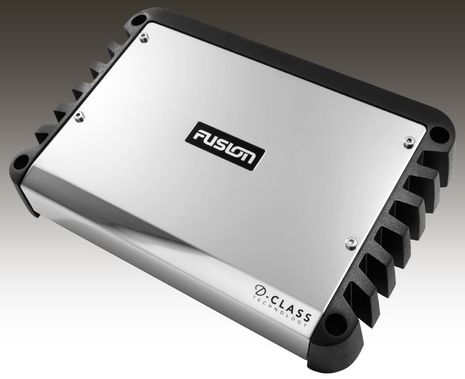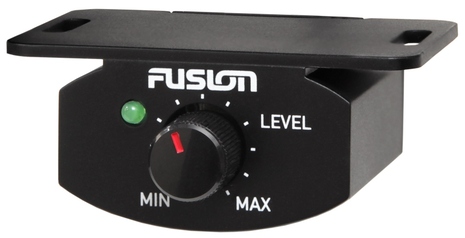Fusion MS_DA51600, freaking peaking 1,600 Watts
While Fusion’s new MS_DA51600 marine audio amp is just being announced this week, a prototype was on display at the Miami Boat Show and I can tell you that the industrial design is even more striking in its cast aluminium and high-polish stainless flesh. But perhaps its real claim to fame is its ability to pump out 4 channels at 80 Watts RMS, plus 250 of sub woofer — and a freaking peak of 1,600 — all via Class D technology that purportedly requires less amps and causes less heat. Who needs that kind of power?…
Well, many boats tend to be noisy environments, and some especially so. I’m thinking particularly of my long 50 knot+ ride with Garmin fishing pro WFO Pratt off Galveston last year. It took a lot of speakers and Watts to cleanly blast Pratt’s favorite XM outlaw country channel over three cranking Yamaha 350-hp 4-strokes, the inevitable boat rattles, and apparent gale-force winds. Like many high-end center consoles, Pratt’s Contender sported a serious system of Clarion — which recently added Fusion-style iThing support — and JBL audio gear. But Fusion is getting a piece of that market (and several others, smaller quieter boats included), and it looks like they’re going for more. The new amp comes with a nice remote level control, for instance, which doesn’t have to be installed but might be quite handy somewhere onboard…
And it seems loaded with connectivity and sonic control. The MS-DA51600 — which has a MAP of $400 — is not online at Fusion Marine Audio yet, but you can find what’s probably a very similar manual on the page of its CA-DA511600 sibling. Plus I bugged Fusion for a high res shot of the amp’s interior connectors and controls. That’s because with enough resolution you can read all the little labels, and also because well-photographed and well-executed industrial design like this borders on geek porn. Click on the thumbnail photo below to enjoy the full money shot!

PS: I’m pleased to note that Poly-Planar recently came out with the MRD80i, a purpose-built marine stereo with a unique internal dock designed to support not just iThings but other MP3 players and smartphones. There’s one sitting in the lab, and I’ll have a review soon.















Well, if the microwave oven fails, here’s another way to cook.
Hmmm…or maybe you could turn out a batch of pancakes with the Fusion logo embossed 😉
You’d really have to crank the volume though, if this scenario is remotely possible. As a Panbo commenter once noted, correctly I think:
“The real advantage of class D comes when playing low volumes, since its idle consumption is near zero (no bias current in the output transistors). As you play louder the actual power delivered to the speaker becomes the larger component, and the difference thus smaller.”
Very impressive looking great markings on the inputs/outputs smart layout design and lots of power in a small footprint. I have 3 Phoenix Gold amps two 50w, one 25w powering Diamond Audio speakers each with crossovers down below with 2-Tweeters, 2-Midrange, 2, larger mids, with 1-sub-woofer,…this was an audiophile system on a 12 meter sailboat dating back to 1997 with 4 newer Alpine spk’s with component tweeters in the cockpit. Back in the day this was considered “high end”. For the head unit newer model Sony marine with an additional 10 cd changer. I-pod interface and wireless remote round out the system This new generation Fusion looks impressive but wonder how they sound.
Our experience has been people with volume to crank, crank it. Toss in some blueberries and ya got a deal. 🙂
Yeah, keep cranking up the volume. If boats, like cars, are to become mobile listening rooms, who wants to hear what’s going on with the boat anyway?
What we’re really saying here is that “It goes to 11.”
It looks remarkably like the 70’s Fosgate Punch setup. It was class D also and would make the mirrors on my truck vibrate so much you couldn’t use them.
Now, marine electronics – gold plated connectors please. It only adds $0.20 to the overall cost of the unit and solves all the white flakey stuff problems.
And I don’t think 40amp fuses will carry a 1600 watt load @ 12 volts… Hmmmmm, me not engeeniir though.
The 40 amp fuses are correct for 1,600 watts peak.
I am in the process of upgrading the speakers in my Jeep. It would be a great mobile test bed for this wattage generator…. Let’s see- Birthday Day coming up.
Ben;
I just recently replaced our stereo on Alchemy (35 Wauquiez Pretorien) with a Jensen DVD player with touchscreen. I was shocked at how much power the thing draws, even when the screen is off. I think it is almost 2 amps just playing mp3 files. On the plus side, it can play many video files off of a usb drive, something I did not expect – and is not even mentioned in their documentation.
Boaters, and sailboaters in particular are always being miserly with their electrical consumption. Is there anywhere that reviews car, and marine stereos for marine use, with power consumption when playing the radio, mp3, etc, as reported data? Is this too hard to measure?
Hi Chris
I was in Mobile Electronics, including magazines and now represent FUSION Electronics to the media.
I independently tested another brand AM/FM/Receiver Amp recently and found nearly 2 amps power drain on standby (unit on/no signal). I thought it was faulty, but apparently not.
FUSION knows that power drain is important to boaters, RV owners and car owners who may run their Entertainment System when the charging system is not operating. Owners also appreciate lower overall power drain at any time. D-class is more than 80 percent efficient. So FUSION chose D-class Hi-Fi amplifiers for their 600 series head units and new amp.
If any entertainment system is going to be run regularly with the motor and therefore charging off, an extra battery for accessories only, is recommended. This avoids being stranded out at sea, or in the case of road travelers, in remote areas.
Power drain is relatively easy to measure, though it fluctuates greatly, according to the sound levels, content and tones. Bass is “power-hungry” and treble draws infinitely much less power.
Kevin
Hi Chris, I think I do have the right tool for analyzing actual stereo 12v usage. It’s the Medusa Power Analyzer Pro I wrote about here: http://goo.gl/cNU8r
I’m not sure when I can get to it, but I could try to measure accumulated Watt hours playing the same playlist over the same speakers at approx the same perceived volume, using the Class D Fusion IP500 (Class D) I still have and some other stereos I’m testing.
In the meantime, I’m curious about your Jensen. Aside from the power issues, do you think it’s a good boat system? And, if so, would you care to write a Panbo review about it?
Ben if you want a review of the system we have on our 12 meter Benteau let me know. Sony CDX-M60Ui, with Sony 10 CD changer.
That would be great, Jeffrey! And it wouldn’t just be Panbo readers who would benefit. I’ll soon be writing an electronics feature for the September issue of Cruising World about onboard entertainment, and it seems like you’ve thought a lot about the subject. Besides discussing the system you put together and how it works, it would be interesting if you added thoughts about what you might do today if starting from scratch. All I need is the words (in most any format) and some photos, hopefully high res. Thanks!
Ben;
I don’t think that the particular unit I got is very good for installation on a sailboat, but I cannot return it, so I will make due for the time being. I can, however, tell you a bit about how this is being used. There are a few other parts to the equation. We have a Vizio 23″ LED TV, that is mounted at the nav station, on a ram ball mount. It “Stores” in an upright vertical orientation, with the lower edge sitting on the surface of the table. It can be used as a computer monitor, either vertically or horizontally, or be swung around to use as a video monitor facing the settee.
Connected to this, we have a Western Digital Live Hub. This is a really neat piece of gear – it has an internal 1Tb hard drive, and will play music, plus just about any video format you can throw at it, including ripped Blue ray videos, at full 1080p. It also has Twonky server software built-in. My wife has an 10″ Android tablet, and you can stream wirelessly from the Live hub to the tablet – music and videos. It all has to be networked together, so there is a Linksys router in there too.
Both the Live hub and the TV use 12v. I have yet to finish the final wiring , but I have a small four-switch sub panel for this stuff, so you can turn on the networking, TV, Hub and stereo independently based on your needs. I also should be able to use the DVD player’s 7″ screen to serve as the Live hub’s screen when selecting music, so no need to use the TV when just listening. It needs a special A/V cable to do that, and the first one I dug up had the pinouts wrong.
Chris
PS – we are trying to sell our active/passive solar house here so we can go cruising: http://www.witzgall.org please visit and like us, using the facebook like button – we are trying to leverage social media to get the word out!!!
THAT is one fine home, Chris, and easy to like. I live in a passive solar house (with some thermal mass) that I built in 1979, and love it. It’s not just the comfort and economy; I like how its true south orientation makes the sun, moon, and stars relate to it in a symmetrical, natural fashion…like a giant sun dial.
Also your entertainment system is quite interesting. And I suspect you might have some good suggestions for me as I try to figure out a good PC & monitor system to use on Gizmo for work and fun (which I’m going to write an entry about today).
One ongoing gripe i have with marine entertainment gear is the lack of support for wide-range DC supplies. This means that i’d need a honking-big 24V-12V converter just to run the bloody amplifier, which very likely converts it *UP* to higher voltage anyway to get the high power without crushing I-squared-R losses. EVERYTHING that is intended for marine use should be good for 10-32VDC supplies!
It’s just not that hard, folks.
BTW – my current nominee for most egregious mis-design of DC power input is the Icom M-820 SSB. it draws a ton of current at full-power transmit
and of *anything* on the boat, it should be glad to be offered a 24-28VDC supply! But noooooo!
-mo